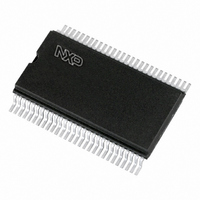PCF8576CT/1,118 NXP Semiconductors, PCF8576CT/1,118 Datasheet - Page 18

PCF8576CT/1,118
Manufacturer Part Number
PCF8576CT/1,118
Description
IC LCD DVR UNVRSL LOW-MUX 56VSOP
Manufacturer
NXP Semiconductors
Datasheet
1.PCF8576CT1118.pdf
(57 pages)
Specifications of PCF8576CT/1,118
Package / Case
56-VSOP
Display Type
LCD
Configuration
40 Segment
Interface
I²C
Current - Supply
120µA
Voltage - Supply
2 V ~ 6 V
Operating Temperature
-40°C ~ 85°C
Mounting Type
Surface Mount
Number Of Digits
20
Number Of Segments
160
Maximum Clock Frequency
315 KHz
Operating Supply Voltage
2 V to 6 V
Maximum Power Dissipation
400 mW
Maximum Operating Temperature
+ 150 C
Maximum Supply Current
120 uA
Minimum Operating Temperature
- 65 C
Lead Free Status / RoHS Status
Lead free / RoHS Compliant
Digits Or Characters
-
Lead Free Status / Rohs Status
Lead free / RoHS Compliant
Other names
568-1080-2
935278818118
PCF8576CTD-T
935278818118
PCF8576CTD-T
NXP Semiconductors
PCF8576C
Product data sheet
7.5.1 Internal clock
7.5.2 External clock
7.5 Oscillator
7.6 Timing
The internal logic and the LCD drive signals of the PCF8576C are timed by the frequency
f
f
The clock frequency (f
for data reception from the I
rate of 100 kHz, f
The internal oscillator is enabled by connecting pin OSC to pin V
output from pin CLK is the clock signal for any cascaded PCF8576C in the system.
Connecting pin OSC to V
external clock input.
Remark: A clock signal must always be supplied to the device. Removing the clock,
freezes the LCD in a DC state, which is not suitable for the liquid crystal.
The timing of the PCF8576C sequences the internal data flow of the device. This includes
the transfer of display data from the display RAM to the display segment outputs. In
cascaded applications, the synchronization signal (SYNC) maintains the correct timing
relationship between the PCF8576Cs in the system. The timing also generates the LCD
frame frequency which is derived as an integer division of the clock frequency (see
Table
internal clock is used or by the frequency applied to the pin CLK when an external clock is
used.
Table 6.
[1]
[2]
[3]
The ratio between the clock frequency and the LCD frame frequency depends on the
power mode in which the device is operating. In the power-saving mode the reduction
ratio is six times smaller; this allows the clock frequency to be reduced by a factor of six.
The reduced clock frequency results in a significant reduction in power consumption.
PCF8576C mode
Normal-power mode
Power-saving mode
clk
clk(ext)
, which equals either the built-in oscillator frequency f
The possible values for f
For f
For f
6). The frame frequency is set by the mode-set command (see
.
clk
clk
= 200 kHz.
= 31 kHz.
LCD frame frequencies
All information provided in this document is subject to legal disclaimers.
clk
should be chosen to be above 125 kHz.
clk
Rev. 10 — 22 July 2010
clk
) determines the LCD frame frequency (f
DD
see
2
enables an external clock source. Pin CLK then becomes the
C-bus. To allow I
Frame frequency
f
f
Table
fr
fr
=
=
[1]
------------ -
2880
--------- -
480
16.
f
f
clk
clk
Universal LCD driver for low multiplex rates
2
C-bus transmissions at their maximum data
osc
Nominal frame frequency (Hz)
69
65
or the external clock frequency
[2]
[3]
fr
SS
) and the maximum rate
. In this case, the
PCF8576C
Table
© NXP B.V. 2010. All rights reserved.
9) when an
18 of 57

















